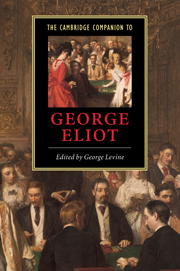Book contents
- Frontmatter
- 1 Introduction
- 2 A woman of many names
- 3 The early novels
- 4 The later novels
- 5 George Eliot and philosophy
- 6 George Eliot and science
- 7 George Eliot and religion
- 8 George Eliot and politics
- 9 George Eliot and gender
- 10 George Eliot and her publishers
- 11 George Eliot
- 12 Works cited and further reading
- Index
2 - A woman of many names
Published online by Cambridge University Press: 28 May 2006
- Frontmatter
- 1 Introduction
- 2 A woman of many names
- 3 The early novels
- 4 The later novels
- 5 George Eliot and philosophy
- 6 George Eliot and science
- 7 George Eliot and religion
- 8 George Eliot and politics
- 9 George Eliot and gender
- 10 George Eliot and her publishers
- 11 George Eliot
- 12 Works cited and further reading
- Index
Summary
”George Eliot” came into existence on 4 February 1857, as the pseudonym offered by 37-year-old fledgling novelist Marian Evans to her new publisher, William Blackwood, to use as “a tub to throw to the whale in case of curious inquiries” (GEL, ii:292). Of all the pen names adopted by Victorian writers, George Eliot's is the one that has proven the most enduring, the one that did not fade away once the gender and identity of the author became known. Even now, after countless biographies have charted the personal life of the brilliant woman who managed to live always at an oblique angle to Victorian middle-class respectability, “George Eliot” retains its singular power to identify both the person and the writer. Exactly because it is an assumed name, it brings into play the odd quality of a life that could develop its great capacities only under the cover of partly fictional social roles. It is also the only stable name attached to the person who was baptised Mary Anne Evans after her birth on 22 November 1819. Each new stage of her life was accompanied by a change in signature, so that one might tell a version of George Eliot's story by following the series of names she asked her friends to call her. Above all, “George Eliot,” laden with all we know about her through her letters, journals, essays, poems, and novels, represents the triumph of a woman's intellectual breadth and ambition through its expression in writing.
- Type
- Chapter
- Information
- The Cambridge Companion to George Eliot , pp. 20 - 37Publisher: Cambridge University PressPrint publication year: 2001
- 3
- Cited by



